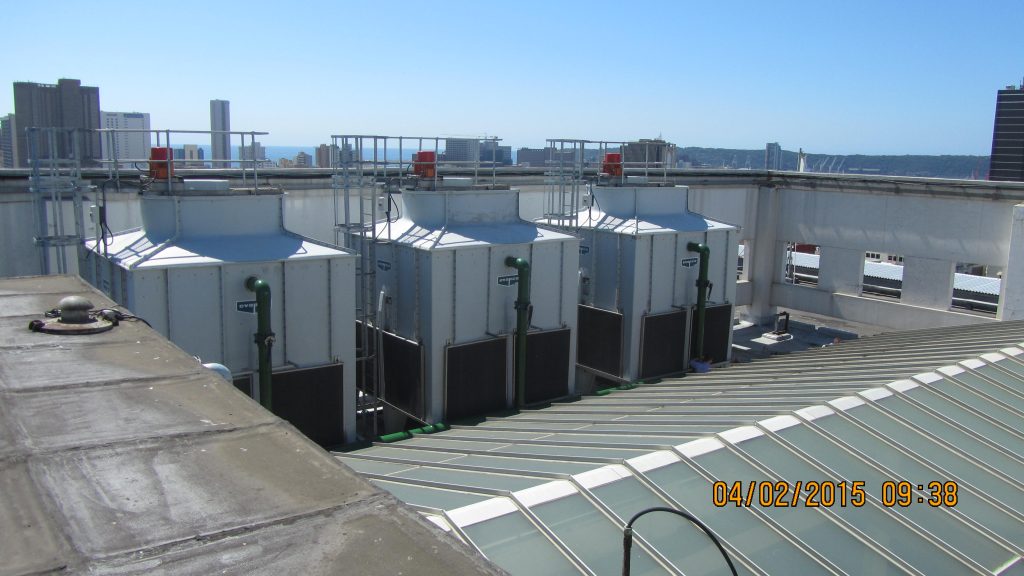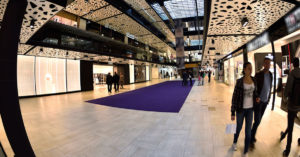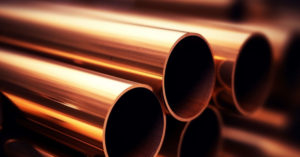BP Centre Durban (Liberty Towers)… West Street’s most iconic building set to lead in the efficiency stakes.
The construction of the BP Centre commenced in 1975. It comprised a 7 storey office tower over a 5 storeyparkade. At this time the various cinema complexes located nearby, were fast disappearing as television took root. This prompted the addition of cinemas, albeit as somewhat of an afterthought. These nevertheless proved popular with both locals and visitors alike, bringing with them a new vibe to the City Centre. For the first time Durban could boast a centre where the workplace and entertainment came together under the same roof.


The original airconditioning system consisted of water-cooled chilled water generators, pumps, cooling towers and air-handling plants, all located on level 5.
In 1995, the Centre was extended with the construction of the north tower, an almost identical building, built hard against its older counterpart. This effectively doubled the size of the complex.
At this time two additional R22 chillers of some 1230 Kwr each were installed on Level 5 to provide cooling for the new tower block.
On completion of the new tower block, the (7OFF) existing cooling towers were relocated to roof level (from the 5th level plant area) to serve the new chillers. By this time, (8OFF) new cooling towers had been installed on the 12thfloor roof of the first tower, to serve the existing chillers.
A total of (40 OFF) small air-handling units were installed on floors 7 to 11 of the new north tower (8 OFF per floor). In addition, fan-coil units were installed to serve the floors corner offices and lift lobbies.
(2 OFF) air-handling units located at roof level provided the required cooled and dehumidified fresh air component to the building.
 In 2007, the now second generation (3 OFF) R22 multistack chillers installed to serve the first tower were replaced with (2 OFF) new R134A machines, providing a total combined cooling capacity of 4204 Kwr(now selected to serve both the north and south office towers as well as the retail floors).
In 2007, the now second generation (3 OFF) R22 multistack chillers installed to serve the first tower were replaced with (2 OFF) new R134A machines, providing a total combined cooling capacity of 4204 Kwr(now selected to serve both the north and south office towers as well as the retail floors).
The original (2 OFF) 1995 vintage second tower R22 chillers were subsequently retained to provide a back-up facility.
During the course of this latter exercise, it became apparent that only 8 of the existing 15 cooling towers would be needed in terms of the revised total heat rejection requirements. As a result, the remaining (7 OFF) cooling towers on the north tower roof were de-commissioned and shut down.
It remains somewhat of a conundrum as to why multiple cooling towers (15 OFF) were installed in lieu of fourat most. One can only speculate as to the reason for this decision at the time. In all probability it had something to do with the project logistics.
In any event, BY 2014, the existing cooling towers, now some 20 years old, were proving problematic as well as being extremely inefficient from a power and water consumption aspect. They were furthermore considerably oversized for the actual (current) building load and duty required of them, delivering 6648 Kw of total heat rejection, 30% more than that required. It was time now to consider their replacement.
After careful consideration, the (8 OFF) existing towers would be replaced with (3 OFF) induced – draft counterflow compositefibre glass / PVC / stainless steel cooling towers with a combined capacity of 5100 Kw total heat rejection. Important considerations included operating weight, weight distribution, total corrosion resistenance, noise criteria, ease of maintenance, overall efficiency and product support.
The Engineers subsequently opted for the Evapco MSS Cooling Tower range, of which (3 OFF) Model MSS 112-4M 12-5 were ultimately selected.
The cooling towers concerned, being of modular construction, were able to be brought to roof level by means of the building’s goods lift. As a result, expensive rigging and craneage was avoided completely, not to mention road closures and all the associated red-tape that goes with it.
Built and assembled insitu, the towers were introduced to the existing condenser water pipework. At the same time, (4 OFF) new PVC make-up water tanks were installed to replace the existing corroded and previously decommissioned steel tank. This now ensures continued plant operation in the event of water disruption of limited duration.
To provide precise head-pressure control, each cooling tower fan is provided with a variable speed drive. Control is by way of the new building management system (BMS).
Installed, completed and fully commissioned, substantial power and water savings are immediately evident. The ongoing drive by Delta Property Fund to improve utility consumption throughout their building portfolio, will indeed be boosted by this upgrade, whereby savings will continue to be generated by the new cooling towers over the next 20 to 25 years.
By : PATRICK BURKE
FSAIRAC
Client : Delta Property Fund
Consulting Engineer : RPM Consulting Engineers (a division of RPM Engineering Group (Pty) Ltd)
Contractor : Ideal Conditions Engineering
Cooling Towers : Evapco
Suppliers : Rod Beuster Agencies (Pty) Ltd
Controls / BMS : Siemens
Supplier / Contractor : Integrated Control Systems (Natal) CC
Variable Speed Drives : Danfoss
Supplier : Danfoss (Pty) Ltd
Contractor : Integrated Control Systems (Natal) CC
Our sincere thanks go to Peter Hamilton for his valued input (Peter was the Contracts Engineer for the original project).
PAT BURKE




